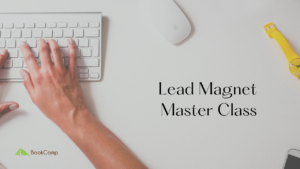As a writer, whether you’re working on nonfiction or fiction, one of the biggest challenges you face is building an audience.
Without readers, you won’t have the benefit of early feedback on your work. You likely won’t be able to land a book deal if you’re going the traditional route. And if you’re going the self-publishing route, if you don’t have readers, your book won’t sell many copies!
That’s where lead magnets come in. These incentives can help you grow your email list, attract new readers, and ultimately increase your chances of success as a writer.
But to create a lead magnet that really works, it’s important to understand the psychology behind what makes people opt-in.

Photo by Milad Fakurian on Unsplash
The Power of Incentives
At its core a lead magnet is an incentive you offer to potential subscribers in exchange for their email address. The incentive can take many different forms, including:
- E-book
- Checklist
- PDF guide
- Webinar
- Worksheet
- Infographic
- List of resource recommendations
- Quiz/assessment
- Template
Why do incentives work? In short, people love getting something for free. When we receive a valuable incentive or feel like we’re getting a good deal, our brains release dopamine, a neurotransmitter that’s associated with pleasure and reward.
This is why lead magnets are so effective. By offering a valuable incentive, you’re triggering the pleasure centers in your potential readers’ brains and making them more likely to take action.
Over the course of six sessions, I’ll walk you through the steps of deciding on, titling, creating, designing, and promoting your lead magnet. Whether you’re a nonfiction or fiction writer, this master class is designed to help you create a lead magnet that will connect with your ideal readers and grow your audience.
And the best part? This master class is taking place inside BookCamp. In addition to the Lead Magnet Master Class, you’ll also benefit from weekly coworking sessions, editorial feedback on your content, monthly group coaching sessions, a private community forum, and much more.
At less than $50/month, BookCamp is an incredible value that can help you get your book into the world. So why wait?
Getting to Know Your Audience
Of course, not all incentives are created equal. To entice people to opt-in, your lead magnet needs to speak to your readers’ interests and needs.
So, who is your ideal reader? This isn’t always easy to figure out, but here are some pointers. Just remember, your audience:
- Is interested in books that are similar to the one you’re writing
- Likes to “geek out” about the same things you like to geek out about
- Follows or engages with other authors or influencers in your genre or niche
As you think about books that are similar to yours, what you like to nerd out about, and which influencers’ interests overlap with yours, you’ll get a better idea of who you’re trying to attract.
Finding the Right Lead Magnet
When you have a clear audience in mind, you can begin to ask: What are their pain points, goals, and aspirations? What kind of information or resources would be most valuable to them?
One key tip is to focus on giving the reader a quick win. Sometimes writers make the mistake of trying to offer everything but the kitchen sink to their readers! It’s not necessary, takes more time than it’s worth, and often results in a more vague, less compelling title.
Metaphorically, if your ultimate goal is to get readers from LA to NYC, focus on getting them to Las Vegas—in other words, just a little bit of the way.
My first lead magnet was a short book called Do Your Art: Rejecting Apathy to Bring Your Best to the World. It’s fine. I’m proud of it. But it took a long time to create, and it’s trying to do too much. Some of my better-performing lead magnets are frankly less ambitious and more specific.
Another tip is to draw on previous successes. If, for example, you’ve been blogging for a while and one blog post has been particularly popular, consider turning this blog post into a lead magnet!
One of my most popular blog posts is “How to Come Up with a Great Book Concept,” so I worked with a designer to create an infographic that presents the content visually.
Finally, if you have a number of lead magnet ideas, give each one the catchiest title you can, then ask your readers to vote on which one they want most.
Title, Title, Title
The title of your lead magnet is one of the most important factors in attracting and converting new subscribers. Often people will decide whether to opt in based solely on the title.
Following are some tips for developing a compelling title for your lead magnet:
- Be clear! If you confuse, you lose.
- Use CoSchedule’s Headline Analyzer: This free tool allows you to input your title and analyzes it for factors like word balance, headline length, and emotional impact. It provides a score and suggestions for how to improve your title to make it more compelling.
- You can also try giving ChatGPT a working title and asking it a question like “Can you suggest a title that’s catchier?”
- Do some browsing. Take a look at some articles about your lead magnet’s topic. Check out Copyblogger’s article titles for inspiration. Consider purchasing and skimming the title templates in Advertising Headlines That Make You Rich by David Garfinkel.
Once you’ve landed a title, remember that it doesn’t have to be the title forever. Test and iterate your titles to see what resonates with your audience.
Don’t be afraid to experiment with different titles or variations, and track your opt-in rates to see which ones perform best. Over time, you can refine and optimize your titles to maximize their impact and conversion rate.
Design Matters
In addition to meeting a need and having a catchy title, your lead magnet also needs to look good. People are more likely to opt-in if the incentive is visually appealing and well-designed.
Right or wrong, people judge books by their covers. The same is true of lead magnets. Use high-quality images and a visually pleasing layout to signal value!
Unsplash is a great resource for free images. And Canva is a great free tool for designing your lead magnet.
Make Opting-In a Cinch
Finally, it’s important to make the opt-in process as easy as possible. People are more likely to opt-in if they can do so quickly and with minimal hassle.
Make sure your opt-in form is easy to find on your website or social media channels, and only ask for the information you really need (usually just a name and email address). Use a clear call-to-action that lets people know what they’ll get when they sign up. Examples are:
- “Download”
- “Click Here for Instant Access”
- “Get Your Free Copy Now”
- “Claim Your Guide”
Keep in mind the psychological principles of commitment and consistency. If someone has opted in to receive your lead magnet, they have already made a commitment to learning more about your topic or solving a particular problem or pain point.
This initial commitment can make them more likely to take further action in the future, such as opening your emails, engaging with your content, or even buying your book! This is one reason it’s important to use clear and direct language in your call-to-action, and to make sure your opt-in form is easy to find and complete.
Conclusion
As a writer, building an audience is essential for success. By understanding the psychology of incentives, focusing on your readers’ needs, developing a compelling title, creating a visually appealing piece, and making the opt-in process easy, you can create a lead magnet that will entice your ideal readers and position yourself as a knowledgeable and helpful resource in your niche.
Over the course of six sessions, I’ll walk you through the steps of deciding on, titling, creating, designing, and promoting your lead magnet. Whether you’re a nonfiction or fiction writer, this master class is designed to help you create a lead magnet that will connect with your ideal readers and grow your audience.
And the best part? This master class is taking place inside BookCamp. In addition to the Lead Magnet Master Class, you’ll also benefit from weekly coworking sessions, editorial feedback on your content, monthly group coaching sessions, a private community forum, and much more.
At less than $50/month, BookCamp is an incredible value that can help you get your book into the world. So why wait?
Question: Now that you understand the psychology behind lead magnets, it’s time to start thinking about what incentive you can offer to entice your ideal readers. What topics would be most relevant to your target audience? What kind of content or resources would be most valuable to them? Share your thoughts in the comments below and let’s start building your audience together!’ You can leave a comment by clicking here.


Wow – What a valuable article! If this is what you offer for free in your blog, I can’t wait to see what you teach in the Master Class! Thank you, Chad, for always serving your audience with such quality and care.
Thank you so much for taking the time to comment, Robyn, and for the kind words. I’m looking forward to the master class!